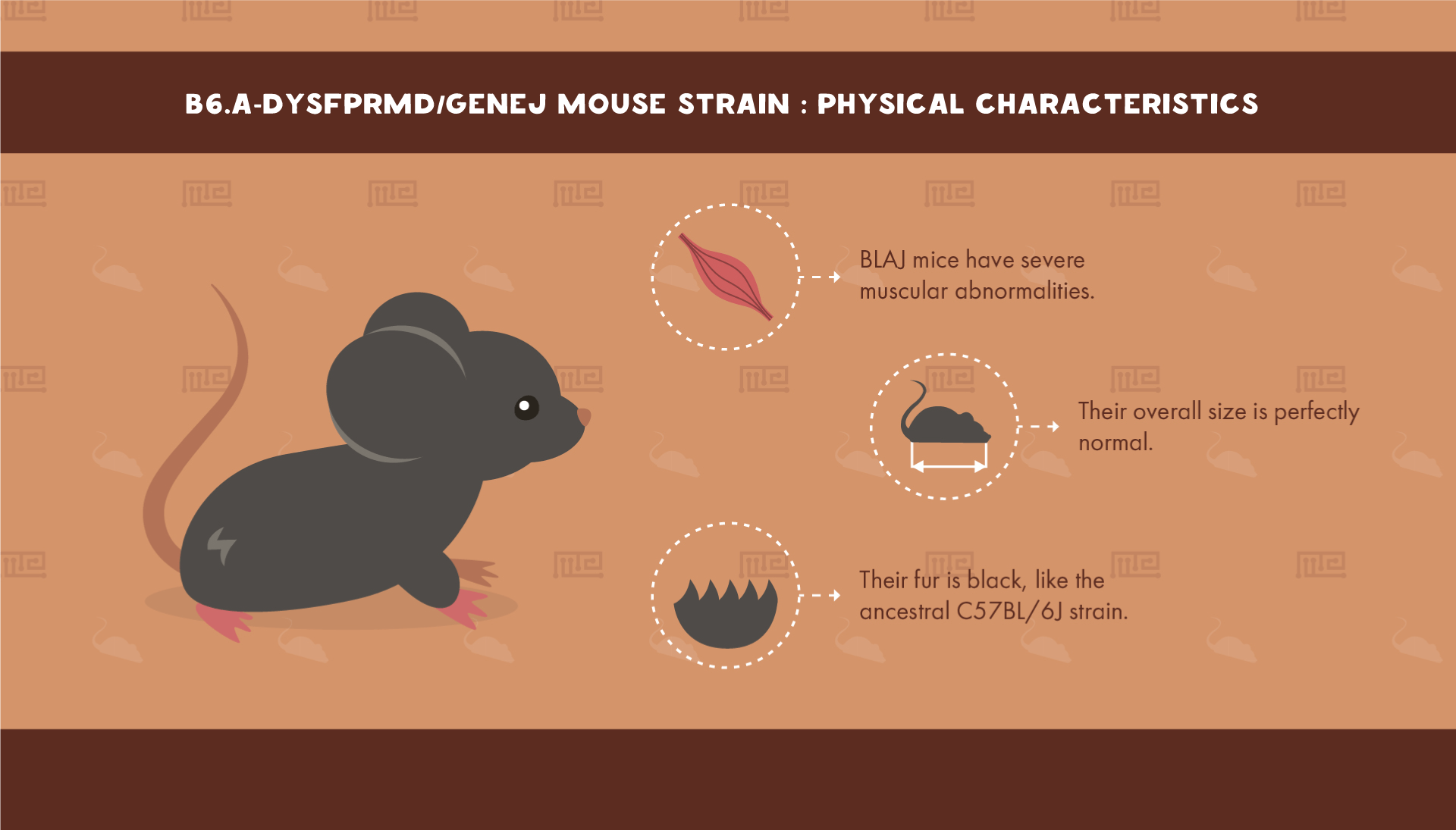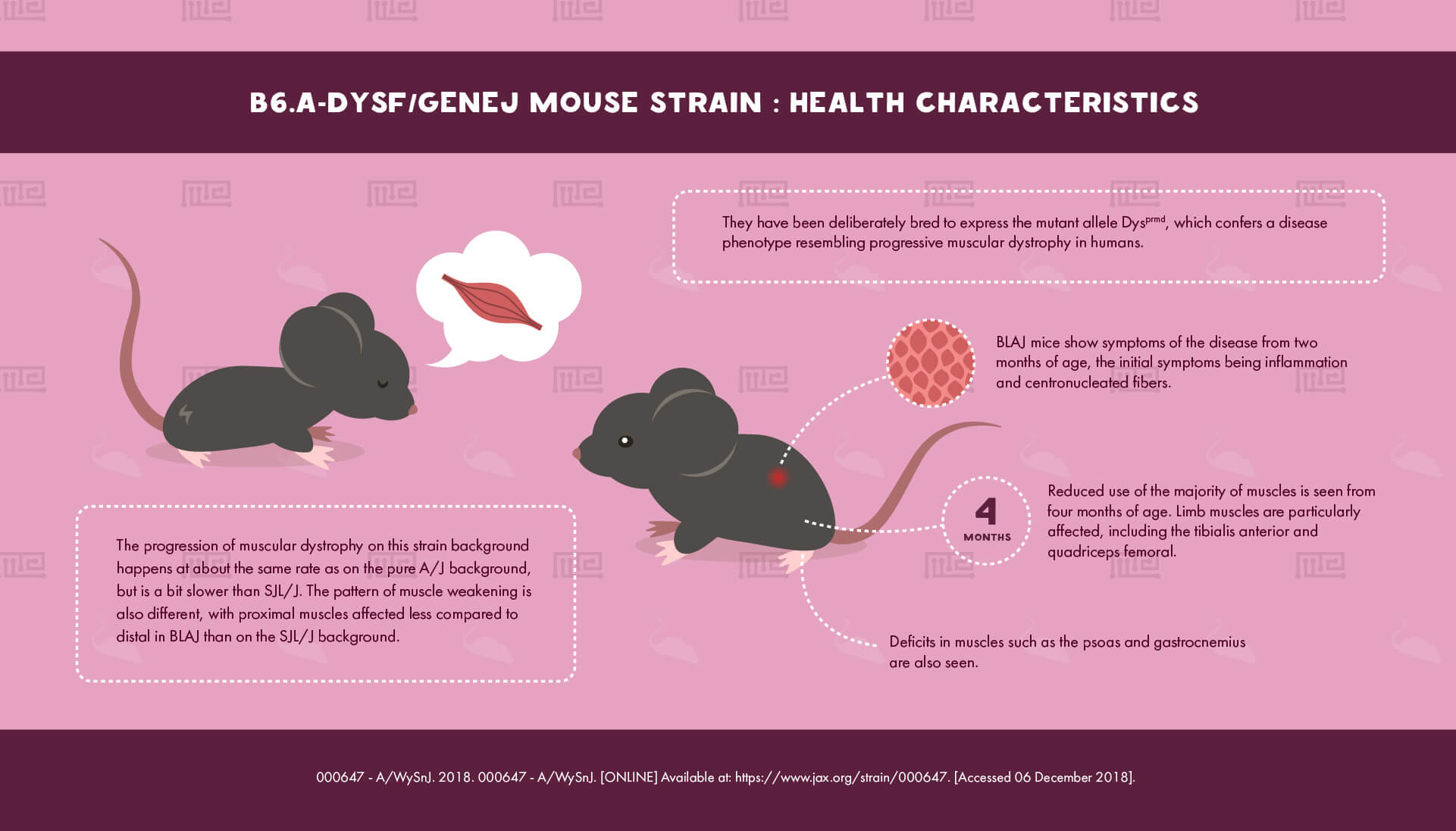History
BLAJ mice are a hybrid of C57BL/6J and mutant A/J mice. An allele conferring muscular dystrophy was first noticed in A/J mice at the Jackson Laboratory. Dr. Isobel Richard introgressed the mutant allele into C57BL/6J through carefully organized breeding with mutant A/J mice.
The stock of hybrid mice passed to Albrecht at the Jain Foundation, where they went through several generations, before returning to the Jackson Laboratory in 2010. These mice were then bred with C57BL/6J for two generations.[1]
Physical Characteristics
BLAJ mice have severe muscular abnormalities (see below), although their overall size is perfectly normal.[1] Their fur is black, like the ancestral C57BL/6J strain.
Behavioral Characteristics & Handling
BLAJ mice exhibit less locomotion in the open field test than the wild type strains, which follows directly from their muscular impairment.[3] In general, BLAJ mice would not be suitable for paradigms requiring a high degree of exertion (such as rotarod, forced swim test etc) unless an impaired control is specifically desired.
Information on the handling of this strain could not be found. Researchers requiring a highly docile strain may thus want to avoid BLAJ as a precautionary measure.
Health Characteristics
These mice have been deliberately bred to express the mutant allele Dysprmd, which confers a disease phenotype resembling progressive muscular dystrophy in humans. The mutation is a retrotransposon insertion that alters the splicing of the gene, leading to an absence of the protein dysferlin. It is hypothesized that the lack of dysferlin prevents muscle cell membrane repair, as corroborated by laser wounding experiments.[4][1]
BLAJ mice show symptoms of the disease from two months of age, the initial symptoms being inflammation and centronucleated fibers. Reduced use of the majority of muscles is seen from four months of age. Limb muscles are particularly affected, including the tibialis anterior and quadriceps femoral. Deficits in muscles such as the psoas and gastrocnemius are also seen.[1]
The progression of muscular dystrophy on this strain background happens at about the same rate as on the pure A/J background but is a bit slower than SJL/J. The pattern of muscle weakening is also different, with proximal muscles affected less compared to distal in BLAJ than on the SJL/J background.[1]
Major Experimental Uses
The BLAJ strain is essentially only of interest to those who wish to study muscular dystrophy. In particular, it is best as the model for type 2B limb-girdle type progressive muscular dystrophy. C57BL/6J should be used as a control.[1]
References
- 012767 – B6.A-Dysf/GeneJ. 2018. 012767 – B6.A-Dysf/GeneJ. [ONLINE] Available at: https://www.jax.org/strain/012767. [Accessed 09 December 2018].
- Mouse Models: Bla/J | Jain Foundation. 2018. Mouse Models: Bla/J | Jain Foundation. [ONLINE] Available at: https://www.jain-foundation.org/scientific-resources/research-tools/mouse-models-dysferlin-deficiency/mouse-models-blaj. [Accessed 09 December 2018].
- Nagy, Nadia & J. Nonneman, Randal & Llanga, Telmo & F. Dial, Catherine & Riddick, Natallia & Hampton, Tom & S. Moy, Sheryl & Lehtimäki, Kimmo & Ahtoniemi, Toni & Puoliväli, Jukka & Windish, Hillarie & Albrecht, Douglas & Richard, Isabelle & Hirsch, Matthew. 2017. Hip region muscular dystrophy and emergence of motor deficits in dysferlin‐deficient Bla/J mice. Physiological Reports. 5. e13173.
- Bashir R, Britton S, Strachan T, Keers S, Vafiadaki E, Lako M, Richard I, Marchand S, Bourg N, Argov Z, Sadeh M, Mahjneh I, Marconi G, Passos-Bueno MR, Moreira Ede S, Zatz M, Beckmann JS, Bushby K. 1998. I A gene related to Caenorhabditis elegans spermatogenesis factor fer-1 is mutated in limb-girdle muscular dystrophy type 2B. Nat. Genet. 20 (1): 37–42.


